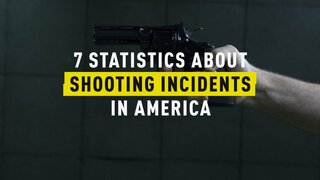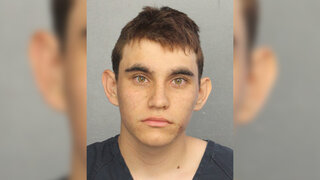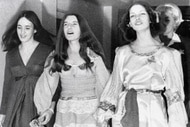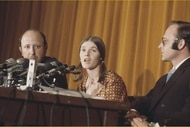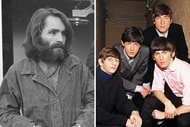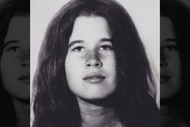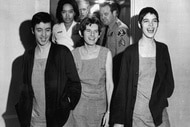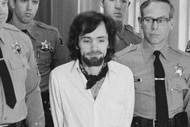Create a free profile to get unlimited access to exclusive videos, breaking news, sweepstakes, and more!
10 Years Later: Revisiting Vengeful Former Cop Christopher Dorner’s Shooting And Manhunt That Left Four Dead
Former LAPD officer Christopher Dorner vowed to turn law enforcement officers and their families into “prey” in retaliation for his 2009 firing and what he believed was rampant racism in the department.
For more than a week in February of 2013, law enforcement officers lived in fear as a vengeance-seeking gunman targeted cops and their family.
The series of callous attacks left four dead and ended in a fiery mountainside confrontation.
The perpetrator, Christopher Dorner’s, death brought an end to the reign of terror that struck fear throughout California, but it also prompted deeper questions about racism within the Los Angeles Police Department and left Dorner’s legacy somewhat in dispute.
RELATED: Narcissism, Ax-Grinding, Copycatting And More Reasons Killers Write Manifestos
1. Who Is Christopher Dorner?
Dorner, a former Navy reserve officer, was once sworn to protect the city’s streets as a Los Angeles Police Department officer, but he set his sights on revenge after he was fired from the department in 2009, CNN reports.
Dorner believed he was wrongfully terminated after filing a complaint against his training supervisor Teresa Evans, who he claimed kicked a mentally ill man in the head and chest during an arrest, according to The Los Angeles Times.
Evans, however, denied the incident and said that Dorner only made the complaint after she informed him that he needed to improve his police work. There were also no witnesses to back up his account and Dorner was accused of making the story up — eventually being fired in January of 2009 after a police investigation into the matter.
For years, Dorner’s rage continued to simmer until it reached a boiling point in 2013.
2. Why Did Christopher Dorner Target Cops?
His rampage began on Feb. 3, 2013 when 28-year-old Monica Quan, a woman’s basketball coach at Cal State Fullerton was gunned down in the parking garage of her high-rise apartment in Irvine alongside her fiancé Keith Lawrence, a security guard at the University of Southern California, according to The Los Angeles Times.
There were no signs of robbery and investigators were initially baffled by what may have triggered the Super Bowl day ambush. It wasn’t until early the next morning that they learned Quan had been the daughter of retired Los Angeles Police Department Capt. Randal Quan.
After retiring, Randal Quan worked as a lawyer representing police officers facing termination and had represented Dorner in his hearing with the Los Angeles Police Department.
3. What Did Christopher Dorner Write In A Letter To “America”?
Police wouldn’t make the connection between Dorner and Quan until someone stumbled on a set of discarded police gear that had once belonged to Dorner in a dumpster. While looking into the former officer, an investigator discovered a lengthy manifesto that Dorner had posted on Facebook after the murders, addressed to “America.”
“I know most of you who personally know me are in disbelief to hear from media reports that I am suspected of committing such horrendous murders and have taken drastic and shocking actions in the last couple of days,” Dorner wrote, according to the news outlet. “Unfortunately, this is a necessary evil that I do not enjoy but must partake and complete for substantial change to occur within the LAPD and reclaim my name.”
The Navy reservist claimed that he had encountered rampant racism on the force, beginning in the police academy when he was shunned after reporting another recruit for a racial slur. He contended the racism only continued from there and described the department as still stuck in “the Rodney King era,” a reference to King’s 1991 near-fatal officer-involved beating that sparked riots throughout Los Angeles.
Dorner believed the department operated under a code of silence that protected its own rather than fight back against racism.
In the 11,000-word manifesto, he vowed to take revenge on law enforcement officers and their families, even bragging about the killing of Quan’s daughter, writing, “I never had the opportunity to have a family of my own, I’m terminating yours.”
“You will now live the life of prey,” he warned officers, according to The Associated Press.
4. Who Did Christopher Dorner Kill?
Fear quickly surged through the law enforcement community. The Los Angeles Police Department provided protection details for about 50 officers and their families, as they tried to identify those most likely to be targeted by the enraged killer, the news outlet reported.
Early on the morning of February 7, a repo man at a gas station in Corona spotted Dorner and flagged down some nearby police officers, according to The Los Angeles Times.
Dorner opened fire on the officers, smashing the windshield, piercing a tire and grazing one officer in the head before he sped off.
Riverside police officer Michael Crain and his trainee Andrew Tachias were working the night shift about 10 miles away. As they stopped at an intersection, Dorner opened fire on the squad car, killing Crain and injuring Tachias in the hail of bullets before fleeing the area, the news outlet reports.
A witness would later describe a grinning Dorner as wearing camouflage and wrap-around goggles as he pointed his assault rifle out the window at the officers and fired.
5. A ‘Case Of Mistaken Identity’
As fear continued to escalate among law enforcement officers, LAPD officers tasked with guarding the home of a captain targeted in Dorner’s manifesto opened fire on a blue truck in Torrance — but the occupants turned out to be an elderly mother and daughter delivering newspapers in the early morning hours.
One suffered a minor wound while the other was shot twice in what then-LAPD Chief Charlie Beck called a tragic “case of mistaken identity,” according to KTLA.
Less than an hour later, Torrance police officers opened fire on another driver who had been on his way to pick up his friend to go surfing in another case of mistaken identity. The man managed to avoid the gunfire.
6. Where Was Christopher Dorner Found?
Investigators finally got a break later that day when they discovered Dorner’s abandoned Nissan Titan still smoldering from a fire on a mountain road in Big Bear, according to the Los Angeles Times.
Deputies believed Dorner had torched the truck after it got stuck on the icy road. Inside they found parts from two AR-15 assault rifles, a handgun, knife, camping stove and charred tent — but no sign of Dorner himself.
For days, law enforcement officers searched the mountain and its scattered vacation homes for the 33-year-old.
On the fourth day of the manhunt, Beck announced he planned to reopen Dorner’s case in an effort to assure the public that the department had been “fair and transparent.”
“I am aware of the ghosts of the LAPD’s past,” he said, according to The Los Angeles Times, “and one of my biggest concerns is that they will be resurrected by Dorner’s allegations of racism within the department.”
What authorities didn’t know was that while investigators were trekking through the snow, Dorner was holed up in a vacation condo just across the way from where law enforcement authorities had set up their command post, quietly watching the investigators activities each day.
“Chilling. That’s the only word I could use for that,” Ed Tatosian, a retired SWAT commander for the Sacramento Police Department, told The Associated Press of Dorner’s nearby hideout. “It’s not an unfathomable oversight. We’re human. It happens. It’s chilling [that] it does happen.”
Dorner was eventually discovered on Feb. 12, 2013 by Jim and Karen Reynolds, the owners of the 13-unit resort where Dorner had made himself at home. The Reynolds came to clean the property when Dorner emerged from the hallway with a handgun.
He forced them into a bedroom, where he ordered them to lie face down on the floor, gagged their mouths, wrapped their heads in pillow cases and tied their wrists and legs with zip ties. He instructed them to recite the alphabet as he made his getaway in their maroon Nissan Rogue, The Times reports.
The couple eventually broke free and called 911.
Officers soon spotted the Nissan Rogue and gave chase, but Dorner was able to escape after crashing the vehicle and stealing another truck.
As officers frantically tried to find the vengeful former cop, Dorner had made his way into a cabin and opened fire on the investigators, striking Alex Collins in the face, kneecap and forearm and killing Deputy Jeremiah McKay, who had been trying to give coordinates to a rescue chopper when he was gunned down, the paper reports.
In a gun battle lasting at least 45 minutes, law enforcement officers faced off with Dorner, before a SWAT team threw a canister of CS gas into the cabin, which sparked a fire. Trapped inside, Dorner took his own life with a single gunshot wound to the head.
7. What Happened After Christopher Dorner's Death?
An internal review by the Los Angeles Police Department would later conclude that Dorner’s firing had been “factually and legally proper,” writing that his termination “was not only appropriate, it was the only course the Department could have taken based on the facts and evidence,” according to a statement from the Los Angeles Police Department.
They also found no basis for the allegations of racism Dorner cited in his manifesto, The Associated Press reported.
They cited his past history of making accusations of racism and grievances against others, bad performance review on the job and the fact that he took more than twice as long as other officers to complete his training as evidence of him being ill-equipped for the job.
“The firing was justified and his allegations are completely unfounded,” civil rights attorney Connie Rice, who reviewed the findings, said at the time. “This guy needed to go. And the question was, even if he needed to go, did the LAPD get rid of him in a way that was illegitimate? And the answer for me was no.”
But not everyone agreed. There were others who supported Dorner, even creating a Facebook page called “We Stand With Christopher Dorner” which, at one point, had over 24,000 likes and earned comments like “you are a true hero,” NPR reported in 2013.
“I don’t defend what Dorner did, but like many in the community, I believe what he said,” a man told Chief Beck at a community meeting following the rampage, according to The Los Angeles Times.
The next year, in 2014, a Los Angeles Police review of its disciplinary system found widespread concerns among officers and others who were among the 500 people who participated in the review, The Los Angeles Times reported that year. The review found there had been discrimination within the department based on ethnicity, rank and gender.
Those who participated in the investigation reported subjective and unfair punishments and noted that misconduct of some high-ranking officials had been overlooked, according to the report.
Dorner’s rampage turned a spotlight on the Los Angeles Police Department and brought about change, prompting the department to set specific guidelines for its disciplinary actions against officers.
Nonetheless, his actions ten years ago claimed the lives of four people, injured others and struck fear deep within a community.
